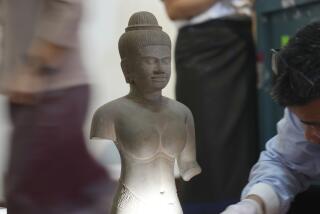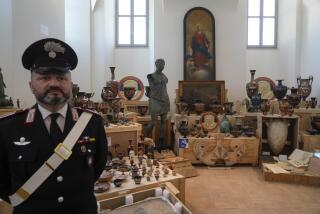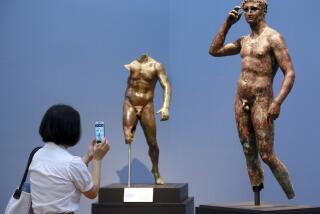Aphrodite now presides in Sicily
AIDONE, ITALY â The J. Paul Getty Museumâs iconic statue of Aphrodite, which became a symbol of American museumsâ involvement in the illicit antiquities trade, was unveiled in its new home Tuesday in the windswept Sicilian hill town of Aidone, marking an end to a controversy that has wracked the museum world for the last decade.
A chaotic scrum of politicians, journalists, townspeople and two Getty officials crowded into the small museum in a former Capuchin monastery to see the 7-foot statue of limestone and marble, which the Getty bought in 1988 for $18 million despite signs that the statue had been recently looted and smuggled out of Italy.
âI feel itâs a great victory for what we call in Italy ethics and law enforcement,â said Francesco Rutelli, Italyâs former culture minister, who negotiated the statueâs return. At one point, Rutelli threatened a cultural embargo of the Getty if the statue was not returned. âIt was a happy ending, but a tough fight.â
Two Getty Museum officials attended the ceremony and thanked Italy for its recent cooperation on a series of archaeological loans that followed the statueâs return. In a statement, Getty Museum acting director David Bomford said that Tuesdayâs event âmarks a new chapter in the story of the ancient sculpture.â
âThe decision to return this statue to Sicily was a turning point in the history of the Gettyâs antiquities collection, one that was fraught with much debate,â Bomford said. âHowever, in the end, based on scholarly and reasoned research, it was, without a doubt, the right decision.â
A parade of regional politicians and Italyâs new culture minister, Giancarlo Galan attended the event in the town of 6,000 people. Sicilians hope the statue will become an anchor for a budding archaeological tourism industry in the region.
The archaeological museum in Aidone where the statue is now displayed sees some 10,000 visitors a year -- a trickle compared with the more than 400,000 who visit the Getty Villa every year. But local officials hope the goddess will soon draw many of the tourists who visit the Roman mosaics in nearby Piazza Armerina, a UNESCO world heritage site.
âOur goal is that within three years, Aidone will have 150,000 visitors per year,â said Sebastiano Missineo, Sicilyâs culture minister.
Under a light rain, a forest service band played the hymn of Sicily. After the crowd gathered at the townâs meeting hall, half a dozen local political figures wearing red, white and green sashes took turns at a microphone saluting the statueâs return. The group then walked through Aidoneâs steep cobbled streets to the archaeological museum, which holds hundreds of objects found in the nearby ruins of Morgantina, an ancient Greek settlement dating to the 5th century BC.
Some of Morgantinaâs finest relics ended up in American museums. But after years of painstaking investigations, the museum has seen a windfall of returns. Also on display is a 16-piece silver service returned by the Metropolitan Museum of Art in New York in February 2010 and two marble busts of the fertility goddesses Demeter and Persephone, once owned by American collector Maurice Tempelsman.
The Gettyâs purchase of the statue of the goddess provoked an international scandal after Italian officials claimed it had been illegally excavated from Morgantina. But clear evidence linking the statue to the site proved elusive, and the statue became a key addition to what would soon become a world-class antiquities collection.
In the 1990s, scientific studies of the statueâs limestone linked it to a Sicilian quarry a half-hour drive from Morgantina. But only after the criminal indictment of the former Getty antiquities curator Marion True did the Getty begin serious negotiations with Italy over the statueâs return.
In 2007, the goddess was one of 40 objects the Getty promised to return to Italy, part of a broader cultural agreement that has launched a new era of collaboration between the museum and its longtime antagonist.
Among the citizens who turned out were several former âclandestini,â the Sicilian term for looters, local officials said. For decades, looting has been a source of income for residents in one of the most impoverished corners of Italyâs poorest region.
The event was marked with moments of confusion as crowds attempted to push into the museum, which officially holds about 150 people.
âConfusion?â remarked a blue-uniformed official of the Carabinieri, Italyâs national police, as he observed the rush. âIn Sicily, it is chaos, not confusion!â
--
More to Read
The biggest entertainment stories
Get our big stories about Hollywood, film, television, music, arts, culture and more right in your inbox as soon as they publish.
You may occasionally receive promotional content from the Los Angeles Times.










